- Dec 26, 2018
 0
0- by A2 Marketing Team
Many people dream of turning their website or blog into a revenue source. Advertising can be an excellent way to generate some supplemental income through your site. However, if you’ve never placed online ads before, it may seem daunting to get started.
Fortunately, Google AdSense is an ad-matching service that enables you to place ads easily and quickly. You don’t even need to track down advertising partners yourself. What’s more, any website owner can use Google AdSense, regardless of what platform you’re using.
In this guide, we’ll explore the basics of Google AdSense, including the types of ads you can create and what sets it apart from other ad services. Let’s dive right in!
When to Use Ads & AdSense on Your Site (And When Not To)
If you have a blog, forum, job board, or just about any other type of website, placing ads on your pages can be an excellent way to offset your costs. That’s especially true if you already get a decent amount of daily visitors. The more traffic and engagement your website receives, the better your ad revenue will likely be.
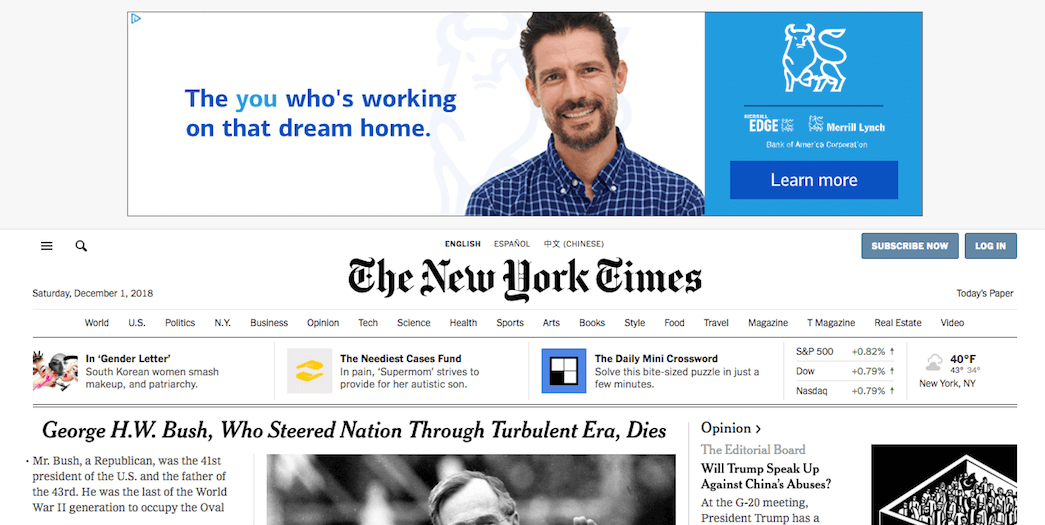
On the other hand, it’s generally a bad idea to place ads on a company website or an online portfolio. This can make your site look unprofessional, by giving the impression that you can’t afford web hosting or you’re desperate to make money.
If you decide that ads would work well on your site, there are many platforms to choose from. Google AdSense, however, is one of the best. It offers plenty of ad types, analytics tools, and other features. Best of all, it’s easy to get started with.
5 Things to Do Before You Start Using Google AdSense
As straightforward as Google AdSense is, you can still benefit from some preparation. Here are a few things you’ll want to consider, before signing up for this service.
1. Understand How Google AdSense Works
In a nutshell, AdSense works by automatically matching advertisers with website owners. It has a marketplace where interested advertisers offer to pay a certain amount to have their ads shown. On the other end, website owners place some code on their sites, which signals that they’re open for business.
Website owners and advertisers can each choose their preferred ad types, sizes, and placements. Google AdSense even enables you to refine the types of content you want to have on your site. When there’s more than one match, the ad spot on a particular website goes to the highest bidder.
2. Review AdSense’s Policies
Before you use AdSense, we recommend reviewing its policies so you’re clear on what is and isn’t allowed. Google has strict regulations about how you can use ads and where you can place them.
For example, as a website owner, it’s forbidden to intentionally solicit clicks. This might include asking your friends to click on ads, or publishing a blog post asking users to support your site by doing the same thing. Google also bars websites with certain kinds of shocking, lewd, or violent content from using AdSense.
3. Decide Whether to Use AdSense’s Auto Ads
Auto ads is a relatively new feature that automatically chooses ad placements based on who is browsing your site. Google uses machine learning to show ads based on personal preferences and levels of engagement with your site. This can help you maximize revenue, yet avoid bombarding your visitors with too many ads.
However, if you do use auto ads, you’ll cede control over how many ads are actually placed on your site. You may only want to use this feature if you feel relatively secure in your user base, or your site’s primary goal is to generate ad revenue. If you want your site to look professional, on the other hand, you may want to retain control over where the ads go.
4. Determine a Reasonable Ad-to-Content AdSense Ratio
If you decide to place ads manually, you’ll have to choose how many to include. Remember that your site’s content still matters. Google doesn’t limit the amount of ads you can have per page, but including too many may irritate your visitors.
You should use your judgment when deciding where and how many ads to place. What’s most important is to highlight your site’s content, not the ads. For example, you may want to keep ads to the top, bottom, or sides of your page, instead of mixing them into the main content.
5. Choose Whether to Use Visitor Data to Target AdSense Ads
Finally, you’ll have to make a choice about ad targeting. AdSense enables you to choose whether or not to use visitors’ data to personalize the ads they see. When you show visitors ads that match their unique interests, they’ll naturally be more likely to click through.
However, there are some downsides to personalized ads. If you get visitors from the European Union (EU), for example, you may also want to consult with a lawyer about the impact of the General Data Protection Regulation (GDPR) on targeted ads. In general, however, most sites with ads can benefit from using targeting.
How to Place Google AdSense Ads on Your Site
Now that the necessary prep work is done, let’s look at how to actually include an ad on your website. You can place an AdSense ‘unit’ on most sites by using some automatically-generated HTML code.
First, you’ll need to create an AdSense account. Once you’ve accessed your account, click on Create an ad, and choose the type of ad you’d like to place:
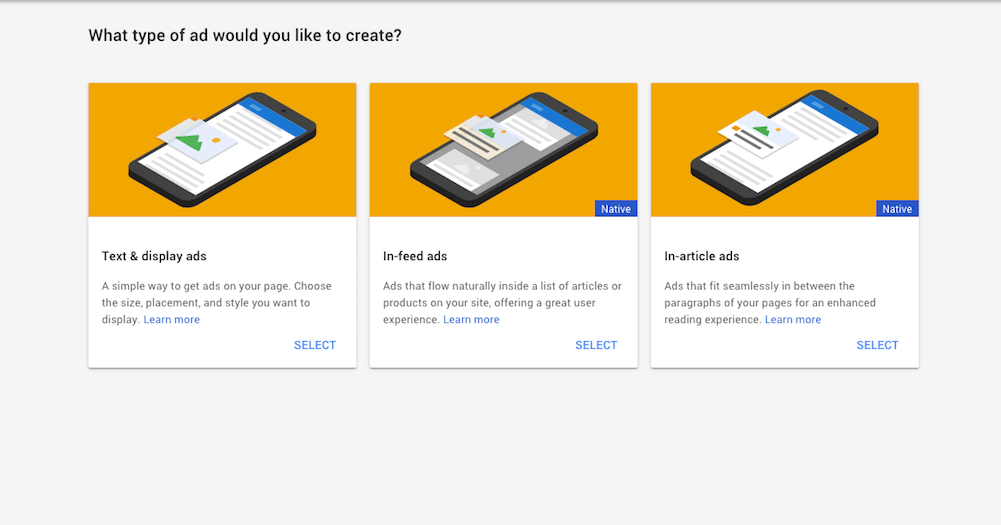
You can then go on to configure your ad’s settings, such as its size and color scheme:
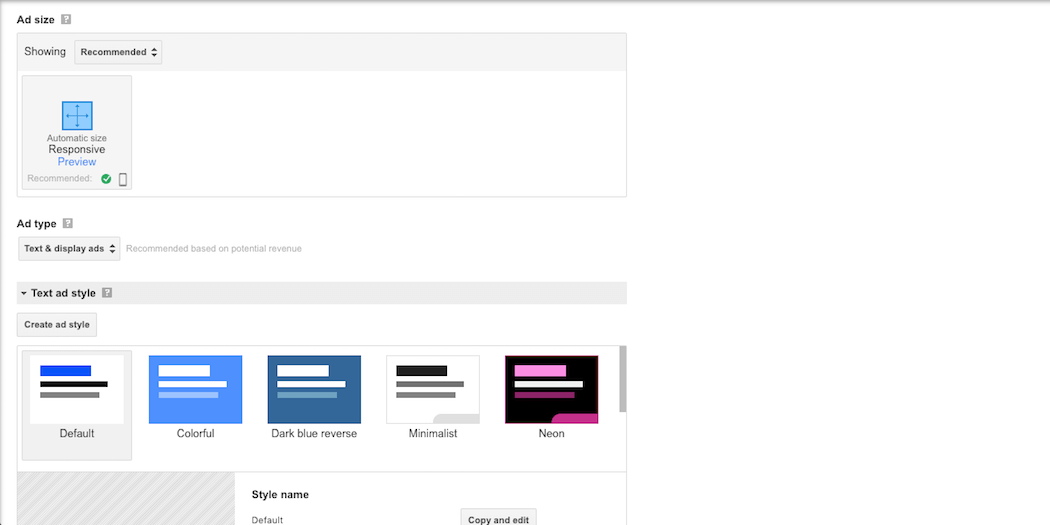
We recommend choosing a responsive size, so your ads will automatically adjust for mobile devices. Then, choose Save and get code, and copy the ad’s HTML:
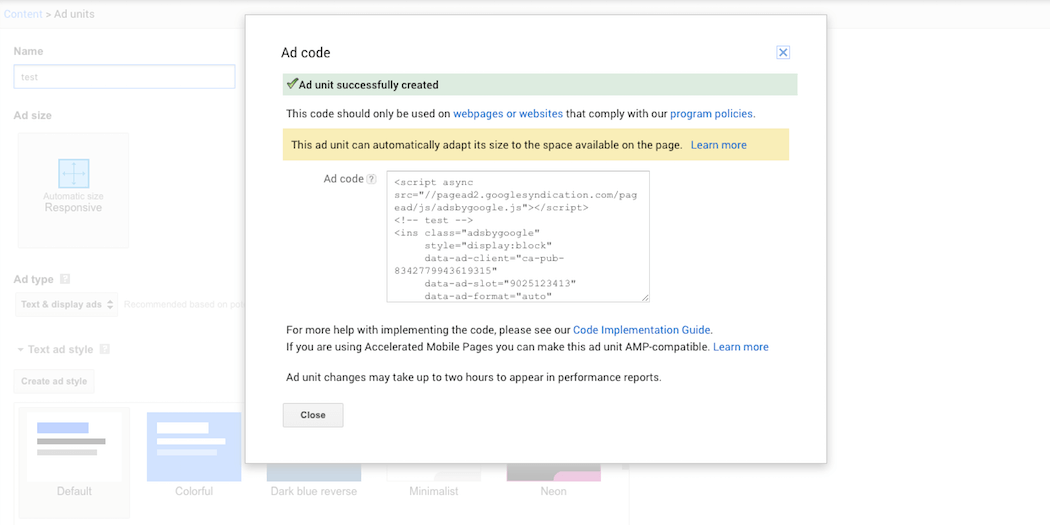
Next, you’ll need to connect your site to AdSense. How you do that will vary based on the platform you’re using. If your site runs on WordPress, for example, you can use an AdSense plugin to get the integration up and running.
In any case, once your site is connected you can place the ad anywhere on your site that allows for custom HTML. Just paste in the code wherever you’d like the ad to go:
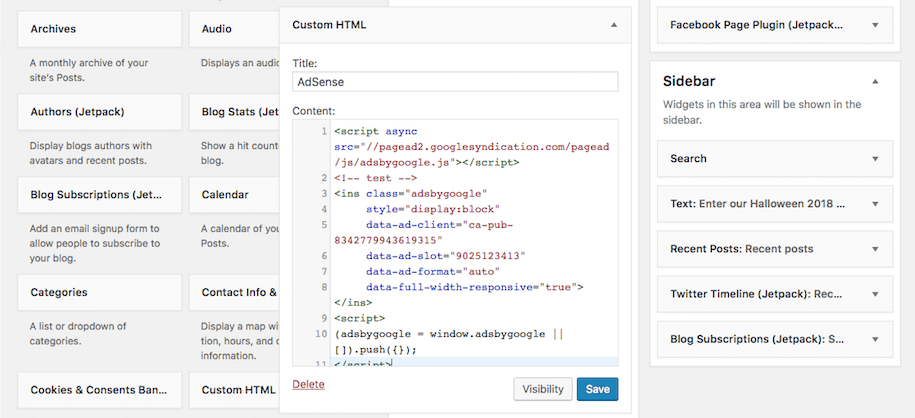
You can repeat this process to place as many ads as you’d like. However, keep in mind our earlier advice about not overwhelming your site’s content with too much advertising – in this situation, less is truly more.
AdSense Conclusion
Placing ads on your site can be an excellent way to generate revenue from your existing audience. There are many online advertising platforms to choose from, but Google AdSense is an extremely popular option thanks to its large network of advertisers and ease of use.
However, it’s important to understand a few things about Google AdSense before you start using it. For example, you need to be aware of its ad placement policies, and understand how to maintain a favorable ratio of high-value content while keeping your ads as unobtrusive as possible. After that, you can set up an account and get to work.
Image source: Pexels.










